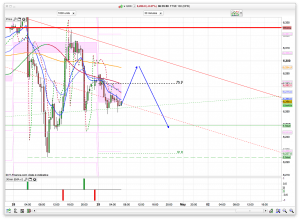Support 6259 6234 6227 6215 6196
Resistance 6282 6295 6305 6326 6369
Good morning. Turned into quite the V shaped recovery day yesterday from that early sell off, all the way up to just tag the 6323 short order right on the bell which was lucky, as the selling then resumed all evening, with the Dow shedding 200 points at one point. I was all se to go long at 6220 yesterday as we hit the neared the 10 day Bianca channel at 6219, and it decided to bounce just above that… typical. Unfortunately the S&P and Dax shorts triggered a bit too early so got stopped out before it fell back which was slightly annoying. Here we are at a Friday before a bank holiday weekend so we wont see too many large positions being opened I don’t think, though it feels weak again especially so after yesterdays evenings antics.
US & Asia Overnight from Bloomberg
The dollar dropped against all of its G-10 peers after weaker-than-expected U.S. economic growth dimmed prospects for a Federal Reserve interest-rate increase at a time when monetary easing is being put on hold elsewhere. Asian stocks fell and crude oil traded near $46 a barrel.
The Bloomberg Dollar Spot Index sank to an 11-month low, while the yen was headed for its biggest weekly jump since 2008 after the Bank of Japan unexpectedly refrained from adding to record stimulus on Thursday. Japanese financial markets are shut for a holiday and an MSCI gauge of shares in the rest of the Asia-Pacific region slid for the third day in a row. The greenback’s decline is proving a plus for commodities, which are poised for their best monthly gain since 2010. Crude has jumped 20 percent since the end of March, while gold and silver are at 15-month highs.
The BOJ’s surprise decision capped a week of fence-sitting for central banks, with the Fed keeping interest rates steady for a third straight meeting and policy makers from New Zealand to Brazil also holding the line. The slowest pace of American economic expansion in two years reignited some concern over the global outlook, and pushed out bets on the potential timeline for tighter Fed policy.
“Central banks look like they have run out of bullets to a degree,” said Mark Lister, head of private wealth research at Craigs Investment Partners in Wellington, which manages about $7.2 billion. “We’re getting to that point where there are limits to the results they can get from anything more they do. This points to a fragile outlook with still a lot of risks out there.”
South Korea’s industrial output unexpectedly declined in March, while Taiwan’s economy shrank more than analysts forecast in the first quarter, data showed Friday. The euro area will release figures for gross domestic product, inflation and unemployment, while U.S. updates on consumer confidence and household spending are also due. Russia’s central bank has a policy meeting and six out of 41 analysts surveyed by Bloomberg predict the benchmark interest rate will be cut. The remainder forecast no change.
Currencies
Bloomberg’s dollar gauge, which tracks the greenback against 10 major peers, slipped 0.3 percent as of 12:48 p.m. in Hong Kong and was set for a 1.7 percent weekly loss. Fed Funds futures show odds of the central bank boosting borrowing costs in June fell to 12 percent following Thursday’s GDP update, having held at around 21 percent when the Fed concluded its policy meeting on Wednesday.
The yen strengthened against all 16 major peers for the second day in a row, climbing as much as 1 percent to 107.08 a dollar, the highest level since October 2014. It surged 4.2 percent this week as the BOJ defied economists’ expectations that stimulus would be stepped up.
BOJ Governor Haruhiko Kuroda told reporters after the review that he wants to wait and see how the introduction of negative rates in January affects the economy.
“The BOJ seems to have descended into a haze of confusion,” said Richard Jerram, the chief economist at Bank of Singapore. “They mismanaged expectations running up to the meeting — and that is clear from the market reaction.”
The yuan rose less than 0.1 percent versus the greenback after China’s central bank boosted its daily reference rate by 0.6 percent, the most since a dollar peg ended in July 2005. The steep increase in the fixing reflects the dollar’s slide rather than any policy intentions, according to Ken Cheung, a currency strategist at Mizuho Bank Ltd. in Hong Kong.
Stocks
The MSCI Asia Pacific excluding Japan Index fell 0.5 percent, headed for a 1.7 percent weekly decline. With the exception of Australia, benchmark shares gauges retreated across the region. Futures on the Nikkei 225 Stock Average tumbled 2.6 percent in Singapore, while contracts on the Standard & Poor’s 500 Index were down 0.2 percent.
Hong Kong’s Hang Seng Index declined 1.4 percent, led by slides in energy stocks. PetroChina Co. slumped 3.4 percent after posting its first loss since it listed in 2000, while Cnooc Ltd. dropped 3.1 percent following a decrease in first-quarter revenue. Exxon Mobil Corp., the largest U.S. energy company, and Chevron Corp. are due to release their results on Friday.
“We advise clients to reduce their investments in equities and other risky assets in both developed and emerging markets,” said Komsorn Prakobphol, a senior investment strategist in Bangkok at Tisco Financial Group Pcl. “We expect the equities to begin some correction in the second quarter after a strong rally so far this year. Oil prices are at a level that will probably see some correction.”
Commodities
The Bloomberg Commodity Index, a measure of returns on 22 raw materials, rose 0.1 percent, extending this month’s gain to 7.7 percent. Oil is set for its best month in a year in New York, buoyed by data this week that showed U.S. output is at the lowest level since October 2014.
Gold and silver both rallied for the fifth day in a row and were headed for their highest closes since January 2015. Copper advanced 0.7 percent in London on Friday, while zinc and lead gained at least 1 percent.
Soybean futures in Chicago are set for an 12 percent increase this month, the most since October 2014, after heavy rains and flooding destroyed crops in South America. Iron-ore futures on the Dalian Commodity Exchange have surged 20 percent this month, the most since the contract started in 2013, and that’s prompted the authorities to clamp down on excessive speculation.
Bonds
The Bloomberg U.S. Treasury Index declined 0.3 percent in April, set for the first monthly loss of 2016. The 10-year yield closed Thursday at 1.82 percent, five basis points higher than at the start of the month. Similar-maturity bonds in Japan yielded minus 0.085 percent at the end of their final trading session in April. [Bloomberg]
FTSE 100 Outlook and Prediction

After that dip last night I think we might see an initial climb as some buy the dippers appear and also as overnight the 6260 area has held a few tests, and we have the 20 day Bianca here at 6259. I think a rise towards the 200ema on the 30min at 6295 is possible and then some bearishness will kick in there. There is a declining channel on the 10min with resistance here also. We also have the top of a falling channel on the 30min at 6305. If the bulls were to break through this then we will likely rise to the top of the 10 day Bianca at 6369, however I think it will be more bearish ahead of a long weekend. If the bears go for it then they will need to break the 6259 channel bottom, which opens up 6215 for the 10 day Bianca channel. So, fairly simple plan today really – inverted V…..
